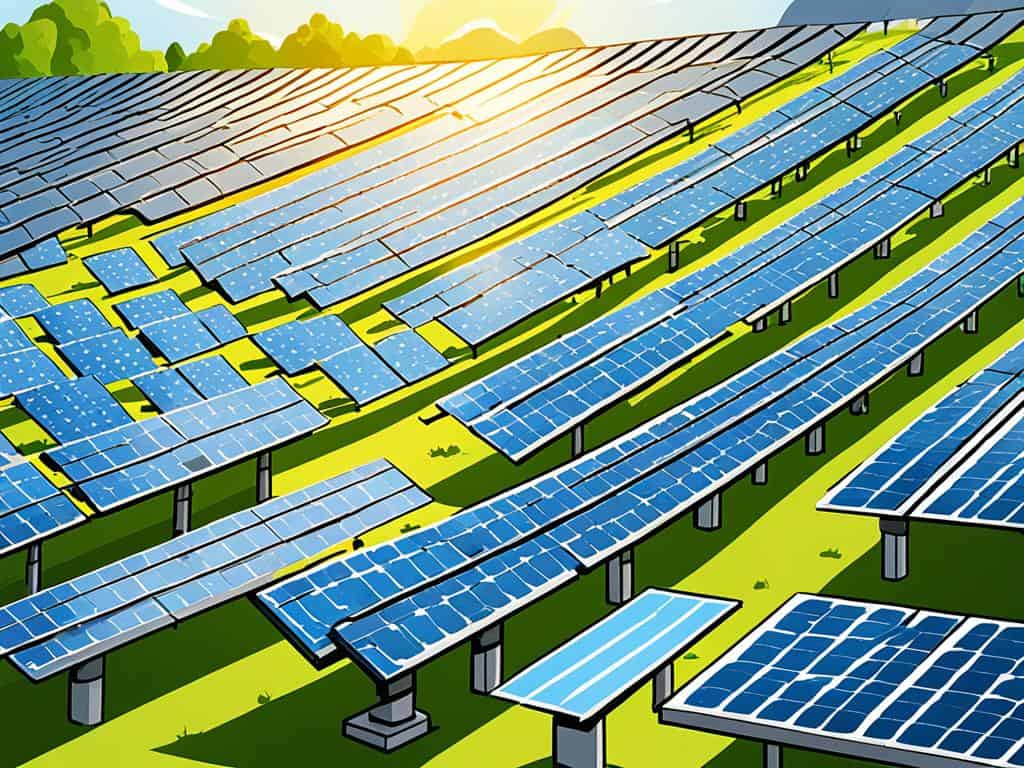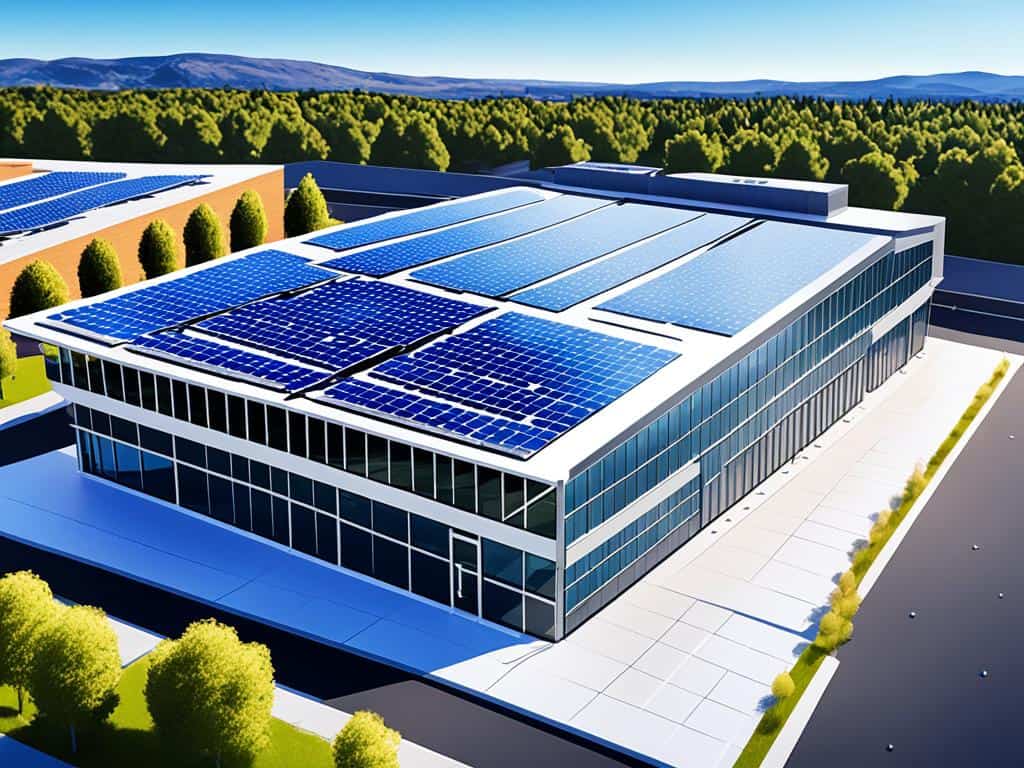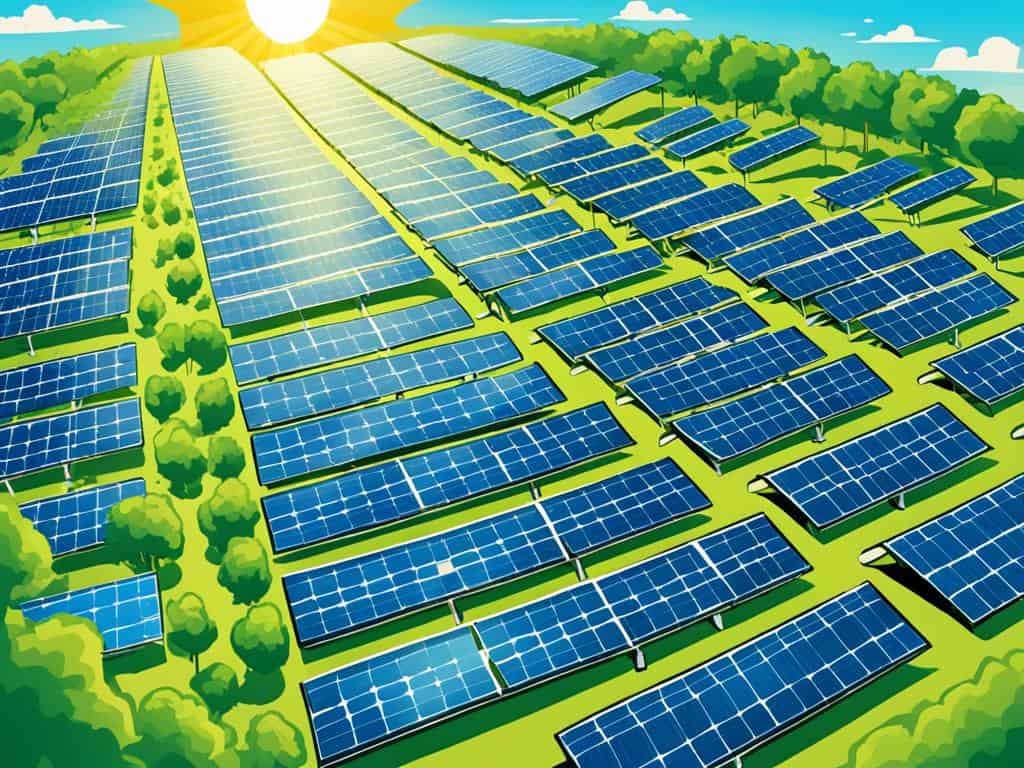Maximize Power: Bifacial Solar Panels Efficiency
Unleash the potential of the sun with bifacial solar panels efficiency. Harness more energy with innovative dual-sided designs in India’s vibrant market.

Let’s change how we see solar tech. Before, solar panels used only one side to capture sunlight. Now, imagine doubling your sunlight collection. This is where bifacial solar panels efficiency comes into play. They are a big step forward in renewable energy in India. These panels use both sides to catch sunlight. Fenice Energy leads the way. They bring over twenty years of experience to India. They are driving a wave of clean energy with this new tech.
Bifacial solar panels are changing the game in renewable energy. They cost a little more, about 10% extra. But, they can make up to 9% more energy than standard panels. This is a good deal for more power. Fenice Energy wants to make sure India can use this tech. They believe it is key for a greener future.
Key Takeaways
- The twin advantage of generating power from both sides sets bifacial solar panels apart, promising a 30% higher rear-side energy gain.
- Bifacial solar panels efficiency translates to higher energy production with less than a 10% additional cost, reiterating their cost-effectiveness.
- Advanced technologies like single-axis trackers and high-performance computing are optimizing these panels for even greater gains in energy.
- The need for consistent industry standards highlights the innovation’s pace and the remarkable potential of bifacial technology.
- Backed by a 30-year warranty from Maysun Solar and with capacity factors that could lower the Levelized Cost of Energy (LCOE), the reliability of bifacial solar panels is commendable.
- Through continuous power generation and energy storage innovations, bifacial solar panels are setting new standards in the solar industry.
Exploring the Design Innovations Behind Bifacial Solar Panels
Solar panel technology keeps evolving with cutting-edge dual-sided solar panels. These panels capture sunlight from both sides. This marks a big step forward for solar power. They not only make solar panels more efficient. They also help build a green energy future.
Double-Glass vs. Single-Glass Panels
It’s important to understand the difference between double-glass and single-glass solar panels. This matters especially when looking at how well they perform in various weather conditions. Double-glass panels are tougher. They provide better insulation and hold up in extreme weather. This is crucial across India’s diverse climates. They degrade slower than single-glass panels. This means they last longer, sometimes up to 30 years.
Photovoltaic Cell Advancements in Dual-Sided Design
Dual-sided solar panels have improved thanks to advances in photovoltaic cells. These improvements help the panels capture and convert light more effectively. Despite higher upfront costs, these panels are a smart investment over time. They benefit significantly from both direct and reflected sunlight. This is especially true in big industrial areas.
Key Materials Used in Bifacial Solar Panel Construction
The materials in bifacial solar panels are chosen for their durability and resistance to damage. They’re tested against tough conditions to ensure they’re up to the challenge. With the goal of supporting clean, renewable energy, these materials are vital. They help reduce panel wear and foster a green energy environment.
Bifacial panels perform better than traditional ones by 5% to 30%. This difference is due to how they’re set up and the environment around them. Companies wanting to cut their carbon footprint and use renewable energy will find these panels very helpful. They reduce harmful emissions and cut down on using fossil fuels. In the end, the breakthroughs in bifacial panels mean more than just numbers. They’re about making our energy use more sustainable.
Bifacial Solar Panels Efficiency: Advantages Over Monofacial Counterparts
Bifacial solar panels efficiency is changing the game in solar energy production. These panels capture light from both sides, pushing their efficiency up by 5% to 30% compared to traditional panels. They are key in driving renewable energy forward, powering industries and homes across India.
The cost of bifacial solar panels is dropping. This makes them an attractive option in the energy market. Fenice Energy notes significant cost savings in industries with high energy needs due to these panels’ higher energy output.
Bifacial panels catch direct and reflected sunlight. This boosts power generation and offers a quicker payback on investment. Fenice Energy believes using bifacial panels will cut down carbon emissions. This supports India’s climate goals.

The use of these panels improves air and water by reducing emissions. Evaluating their full life cycle cost and impact is vital to understanding their sustainability.
By 2021, bifacial cells constituted half of the solar market. This is expected to reach 85% by 2023. Their use alongside advanced tracking systems increases solar output by up to 35%. This is important for India’s energy progress.
Fenice Energy is excited about these advances, with outputs now over 600 watts and warranties of up to 30 years. These benefits mark a big step towards a greener future.
“Harnessing solar energy is at the forefront of the renewable revolution. Bifacial solar panels, with their superior efficiency and longer lifespan, are not just an energy solution but a cornerstone for a sustainable future.” – Fenice Energy
- Increased output and energy savings
- Positive environmental impact through reduced emissions
- Enhanced panel performance with high albedo value installations
- Long-term reliability signified by extended warranties
The many advantages of bifacial solar panels make a strong case for their role in India’s energy future. Fenice Energy is leading the way with innovative, sustainable solutions.
The Impact of Installation Environment on Bifacial Panel Performance
New developments in solar panel technology, like bifacial modules, could change renewable energy forever. India now wants to reach 100 GW of solar energy, thanks to this tech. Gujarat leads by adding 2 GW of solar rooftops.
Bifacial modules are special because they catch light from both sides. This means they need less room and give more power than old panels. Fenice Energy, experts for over 20 years, say good design means more efficiency and happier customers.
In places like Gujarat, where the sun is extra bright twice a year, this tech is crucial. Fenice Energy notes bifacial panels work well with the local weather, boosting solar energy production. More people in homes, factories, and rural areas are choosing these panels, showing they’re loved by many.
- In places with bright ground, like sandy or rocky areas, bifacial solar panel technology is better. It captures more light, making more electricity from the panel’s back.
- Finding the best way to set up bifacial panels is key. This research helps get the most energy, proving the smart design of these solar panel technology solutions.
- Experts are always working to make bifacial tech better. Soon, it might rule the market, making up over 90% of sales.
- Fenice Energy’s push for top renewable energy fits with new quality rules. These ensure bifacial panels always perform well.
A 5 kW bifacial system shows why they’re better than old panels. They save money and use space smartly, making them great for energy-smart folks in India.
As India moves to greener energy, making solar panel design fit buildings is key. Fenice Energy is leading this change. They make sure clients get the best bifacial technology. This means cleaner, more effective renewable energy for everyone.
Optimizing Bifacial Panel Placement for Maximum Sunlight Capture
To fully benefit from dual-sided solar panels, it’s not enough to have advanced technology. Thoughtful placement and orientation are key to tapping into the sun’s power. In India’s growing solar energy scene, knowing the local landscape helps capture more energy. Fenice Energy uses their deep experience to boost these panels’ performance.
Influence of Tilt and Orientation on Efficiency
The tilt and orientation of solar panels are crucial. For dual-sided panels, the right position can greatly increase energy production. Starting with a tilt that matches the site’s latitude is smart, but adjustments may be needed. The panels should generally face south in the northern hemisphere to catch the most sun, making both sides of the panel work harder.
Site Selection Criteria for Ideal Light Reflection
Choosing the right site is key to getting the most from dual-sided solar panels. Surfaces that reflect light, like white concrete or snow, can boost the energy captured. In India, with its varied landscapes, finding spots with good ground reflection can greatly increase power output. Fenice Energy aims to maximize site reflectivity to enhance panel efficiency.
By analyzing sites for their reflective qualities, Fenice Energy ensures their dual-sided panels are set up for long-term success. They’re helping India meet its future energy needs.
Cost-Benefit Analysis: Is the Investment in Bifacial Worth It?
India is making big moves towards a future powered by renewable energy. In this journey, bifacial solar panels stand out. They might cost more up front compared to normal panels, but they work better and can generate more power. This makes them an interesting choice for investing.
The big win with solar panel efficiency comparison is that bifacial panels grab sunlight from both sides. This increases how much energy they can make. It also means they pay for themselves quicker. Fenice Energy leads in using these advanced panels, helping Indian customers use less traditional power.
Now, let’s take a look at the reasons bifacial technology is so tempting:
| Aspect | Monofacial Panels | Bifacial Panels |
|---|---|---|
| Efficiency | Standard | Up to 30% more |
| Longevity | 20-25 years | Greater due to double-sided capture |
| Cost Reduction in BOS | Lower | Higher, compensating for initial investment |
| Energy Yield | Dependent on direct light | Enhanced by reflected light |
| ROI Time Frame | Longer | Shorter due to increased output |
| LCOE | Standard rate | Reduced by up to 65% |
Bifacial solar panels efficiency might be a key player in India’s shift to clean energy. Fenice Energy showcases how bifacial technology can offer more benefits than costs. This move is all about building a sustainable and energy-secure India.
Even though they’re pricier at first, bifacial panels symbolize a dedication to renewable energy. They reflect a wider goal of sustainability and smart finance. These panels are more than just technology. They’re a step towards a better future of power production.
“Investing in bifacial solar technology is not simply a matter of immediate cost but rather a direct investment into the future of renewable energy and sustainability.” — Fenice Energy
Understanding Bifacial Solar Panels Efficiency
Bifacial solar panel technology represents a big leap forward in making solar energy. Since 2018, these panels have started changing how we produce energy from the sun. They generate power from both their sides using clear solar cells and special materials. This lets them collect light not just from the sun above but also from reflections below.

Fenice Energy sees big potential for these panels in India. They’re improving clean energy in India with better solar technology. Bifacial panels have two active sides, making them better than old panels that only use one side.
The performance of these panels is measured by “bifacial gain” and “bifacial ratio.” Bifacial gain tells us how much more energy the back side makes, in a percentage. The bifacial ratio compares sunlight received on both sides to show efficiency.
The growth of solar panel tech shows the importance of clear solar cells in bifacial systems. It’s key to use them fully and well.
Fenice Energy bets on advanced tech like N-type cells in HJT and TOPCon systems for better bifaciality than in PERC tech. Glass-glass designs in these panels, used by leaders like Trina Solar, allow more light through and stand up better to weather.
The world’s solar energy use grew a lot, hitting 4.5% of all energy made in 2021. This will grow as bifacial tech gets more popular. Bifacial panels make more energy and save money, offering up to 15% more energy and less cost over time.
Bifacial panels work best when set up just right, like how high they are and how far apart they are. Fenice Energy focuses on these details in their installations in India. This shows their dedication to advanced, renewable energy solutions.
Enhancing Energy Production with Reflectivity Techniques
Bifacial solar panels have made huge advances in both efficiency and affordability. India is making big strides in using sustainable energy. The key to their success is using sunlight more effectively, which leads to more power.
Materials and Surfaces that Improve Backside Energy Capture
Bifacial solar panels can be up to 30% more efficient than old-school ones. This is thanks to reflectivity. It means the panels can use light bounced off the ground or special paints. Places with high albedo are best. They achieve more light reflection, saving energy and reducing carbon emissions.
Installation Tips to Avoid Efficiency Loss
Putting in bifacial solar panels is not just about placing them anywhere. You must think about the land, shadows, and how the panels are set up. Since 2016, bifacial tech has gotten better, offering more energy. SolarFarmer software helps get the most out of these panels.
Using solar tracking systems can add up to 40% more operational time. This makes energy production more stable. Careful installation prevents shade on the back of the panels. Fenice Energy, a leader in clean energy, uses these methods to maximize solar panel effectiveness.
Weather and Seasonal Influences on Bifacial Panels’ Performance
In India’s varied climate, the performance of dual-sided solar panels changes a lot with the environment. Regions with a lot of snow see big changes in solar energy production. Thanks to Fenice Energy’s skills in improving clean energy, we know snow’s reflection can boost bifacial panels’ output. This is key for areas wanting to increase renewable energy use and efficiency all year.
How Snow and Rain Affect Dual-Sided Solar Efficiency
Dual-sided solar panels work really well in snowy areas. The white snow acts like a mirror, increasing energy capture on the panels’ back side. However, rain can clean the panels but might momentarily lower efficiency by blocking sunlight. At Fenice Energy, we make sure these panels are set up just right to get the most light for the best performance.
Seasonal Positioning Adjustment for Optimal Energy Harvest
Adjusting the panels with the seasons is key for the best energy production. Fenice Energy has studied India’s unique landscape and found that changing panel positions with the sun’s path boosts energy harvest. They also consider local factors, like the PV modules’ average yearly degradation rate of 1.47% in India. This helps Fenice Energy offer cleaner energy solutions that respond well to seasonal changes, improving power output and investment returns.
Dual-sided solar panels are becoming big in renewable energy. By placing panels smartly and adjusting them seasonally, we can use their full potential. Fenice Energy is all about innovation, and with help from top research groups like NREL, India is leading in using bifacial solar technology effectively.
FAQ
How do bifacial solar panels improve renewable energy efficiency in India?
Bifacial solar panels capture sunlight from both sides. They use scattered and reflected light. This boosts energy by up to 30%, which is perfect for sunny places like India.
What are the design innovations behind bifacial solar panels?
These panels have two layers of glass for more toughness. They use transparent cells and reflective materials. This makes them better at catching light and generating power.
How do double-glass panels compare to single-glass panels in bifacial modules?
Double-glass panels last longer and insulate better than single-glass panels. They degrade less over time. This means they’re a good fit for India’s harsh weather.
What advancements have been made in photovoltaic cells within dual-sided solar panel design?
New tech in these cells includes layers that let light in from the back. There are also improved structures. Together, they lift the panel’s energy creation from both sides.
What are the benefits of bifacial solar panels over traditional monofacial panels?
Bifacial panels make more electricity by using light from both sides. They last longer, with guarantees of up to 30 years. They also use land more efficiently. This makes them a smarter, greener choice for solar power.
How does the installation environment affect bifacial solar panel performance?
The right setting enhances the power of bifacial panels. Factors like ground shine, setup angle, and no shade on the back matter. The best environments boost the panels’ efficiency a lot.
What factors influence the tilt and orientation of bifacial solar panels?
The best tilt and direction catch the most sun. This means thinking about where the panels are, the sun’s path, and how the environment reflects light back.
How does site selection criteria affect light reflection for bifacial panels?
Picking the right spot is key for these panels. You want places with lots of light bounce, like white concrete. The place’s geography and shape are also important.
Is the initial investment in bifacial solar panel technology worth it?
Yes, even if they cost more at first, bifacial panels pay off faster. They last longer and may boost property value. This makes them a smart money choice.
How can the efficiency of bifacial solar panels be further augmented?
For more power, use shiny ground materials or special coatings. Setting up the panels to avoid back shade is key.
Do weather and seasonal changes affect the performance of bifacial solar panels?
Definitely, things like weather and the time of year can change how well they work. Snow can increase power. Adjusting the panels with the seasons helps keep energy steady all year.


